What’s new is the M6’s more compact body design, intended to appeal to the “take anywhere” camera enthusiast, and doing away with the M5’s built-in electronic viewfinder (EVF). Instead, the M6 is compatible with the optional $210 EVF-DC2 accessory, which offers 2.36m-dot resolution and attaches via the M6’s hotshoe. The M6 also adds a couple of new features, including a tilting flip-up LCD screen for selfies and — in a first for Canon cameras — a built-in 5-axis image stabilization system for video (but not for stills).
Compatible with the existing line up of 7 EF-M mount lenses, including both zooms and a couple of “fast” primes, shooters can use the full range of Canon EF and EF-S lenses on the EOS M6 via the optional $200 EF-EOS M Mount Adapter.
Highlights and specifications
- Compact design
- 24.2Mp CMOS APS-C sensor
- 5-axis image stabilization for video
- Dual Pixel CMOS AF with Phase-detection
- Burst shooting at 7fps, up to 9fps with no AF tracking
- Touchscreen LCD with tilt control
- EF and EF-S lens compatible via an adapter
- Wi-Fi, NFC & Bluetooth connectivity
- $779 (body only)
- ISO 100-25,600
- 3-inch 1.04m dot tilting touchscreen LCD
- 1080/60p video
- Canon EF-M lens mount
- Available in silver or black
Potential drawbacks
- No built-in EVF
- No 4k-video
- Limited range of dedicated EF-M lenses
Overall image quality
For an APS-C hybrid camera, the EOS M6’s scores are good and comparable to recent Canon mirrorless and APS-C format DSLR sensor scores. Image quality on the EOS M6 has seen significant improvement and, achieved better scores across the board over the original EOS M, which scored 65 points overall. For roughly the same money, the Sony a6000 scores a little higher in all categories, although to be fair, the results are very close, and there’s not much in it in real-world terms. Head-to-head against the best-performing APS-C mirrorless camera in our database, however, the Sony offers around a half-stop better color depth and dynamic range at base ISO, and slightly improved results for noise, too.
Image quality results by use case, compared
Our head-to-head analysis pits the EOS M6 against the top-performing Sony a6300 APS-C mirrorless camera ($898), as well as against Canon’s mid-range EOS D80 DSLR ($1,099).
In summary, the image quality for the EOS M6 is very comparable to the EOS 80D, while the Sony a6300 offers an advantage both at base ISO (where sensors offer the best image quality) and at higher ISO settings.
Image quality – Sports (low-light ISO)
For capturing parties and events indoors, or shooting action with fast shutter speeds in low-light conditions, it’s often necessary to crank up the ISO. Larger APS-C sensors offer an advantage, compared to physically smaller sensors in compact and bridge cameras, and the results from the EOS M6 are encouraging. Signal-to-Noise Ratios (SNR) in prints are broadly the same for the EOS M6, the EOS 80D, and the Sony a6300 up to ISO 6400.
Images with well-controlled noise and a SNR over 30dB, as well as with good dynamic range and color sensitivity, are possible on all three cameras up to ISO 1600. So don’t be put off of increasing the sensitivity if needed. It’s worth noting that our Sports (low ISO) score is only a relative measure of ISO performance using each camera’s RAW files, so with good in-camera processing or careful post-production processing, good print quality is attainable at higher ISO’s.
Image quality – Landscape (dynamic range)
Shooting in good light, or using a tripod, enables the use of much lower ISO sensitivities, and all three sensors offer great dynamic range at ISO 100. The Sony a6300 is the best, offering improvement of more than one stop over the EOS M6 at ISO 100 (13.73 EV vs 12.57 EV), thus capturing scenes with greater levels of contrast and a wider tonal range.
The EOS 80D also offers a modest half-stop improvement at ISO 100 over the M6, so a little less significant, and the gap narrows further as ISO is increased, with the Canon mirrorless and the DSLR essentially offering the same dynamic range between ISO 400 to 6400.
The a6300’s one-stop advantage at base ISO is broadly maintained as sensitivity increases, too, so good dynamic range over 10 EV is possible on the Sony up to ISO 3200, compared to ISO 1600 for the Canon chips. This is significant for photographers after improved results in lower light conditions — specifically indoors, or where very fast shutter speeds are required.
Image quality – Portrait (color sensitivity)
Color sensitivity is close at base ISO, and although the Sony offers a modest one-bit improvement over the M6 (24.4 bits compared to 23.4 bits), both offer excellent color for portrait skin tones or for rich color landscapes up to ISO 400. The a6300 again benefits from an uplift in quality as ISO is increased, recording good color over 20 bits on the Sony at ISO 1600, compared to 19.5 bits on the M6 at ISO 800.
The Canon mirrorless and DSLR sensors are very comparable for color throughout the sensitivity range, and although the EOS M6 offers a modest improvement at the highest ISO sensitivities (12,800 and 25,6000), the difference isn’t significant.
Conclusion
While early EOS M-series mirrorless cameras underwhelmed a little, the new M6 has the features and image quality to be a serious contender in the hybrid market, as long as you don’t want 4k video.
For photographers considering an update from an older EOS M, M2, M3 or M10 model, the improved specifications make the M6 a worthwhile upgrade. While the exclusion of a built-in EVF is probably a deal breaker for serious enthusiasts, they aren’t the M6’s target market, with the larger DSLR-style EOS M5 still in the Canon lineup to meet their needs. Of course you can add the accessory EVF to the EOS M6, but that adds $200 to the price, makes it bulkier than the M5, and limits the use of the hotshoe for a mounted flash, so not ideal.
Is it right for you?
For enthusiasts wedded to the Canon system and looking for a small mirrorless camera to use with existing EF-M, EF-S, or EF-mount lenses, the EOS M6, alongside the EOS M5, offers the best features and image quality for a Canon hybrid to date. The compact size is perfect for slipping it into a small day bag for trips out, especially when coupled with the pancake-style 22mm EF-M prime lens. If you’re planning to shoot a lot outdoors in bright light, where glare can be a problem, the omission of a built-in EVF is problematic; this makes the M5 a better choice, but it’s bigger and bulkier. For those not committed to a particular brand, any of the Sony a6xxx-series mirrorless cameras offer the same compact styling as the EOS M6, but with the benefit of a built-in EVF, together with marginally better image quality, in roughly the same price bracket.
Also consider
For greater insight into the performance of alternatives to the Canon EOS M6, please see our Sony a6300, Sony a6500, Canon EOS M5, and Panasonic G80/85 sensor reviews.


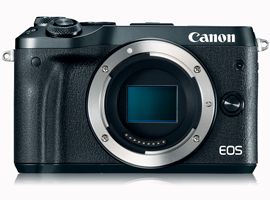



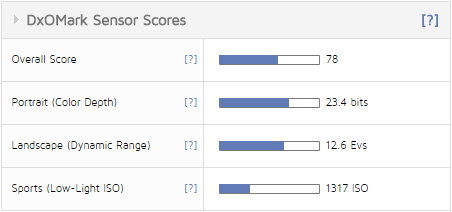
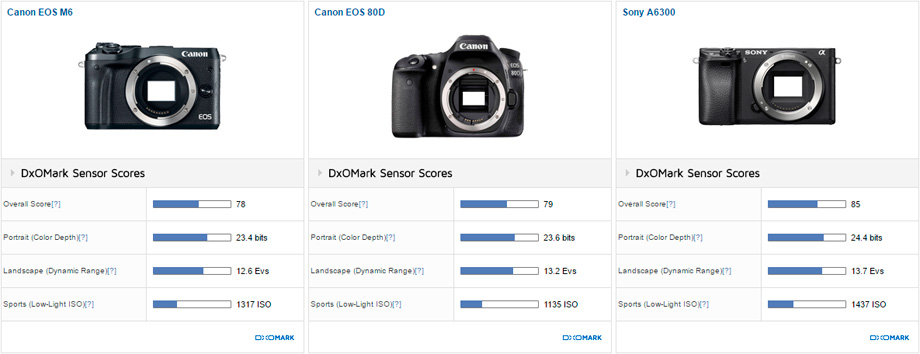
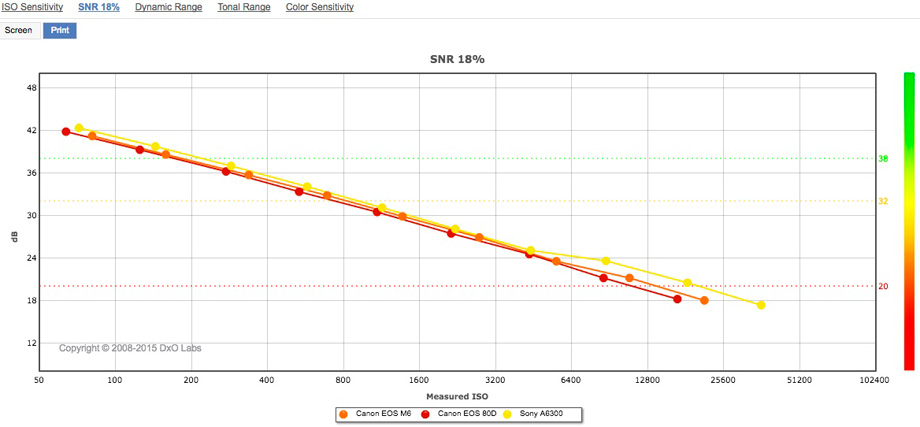
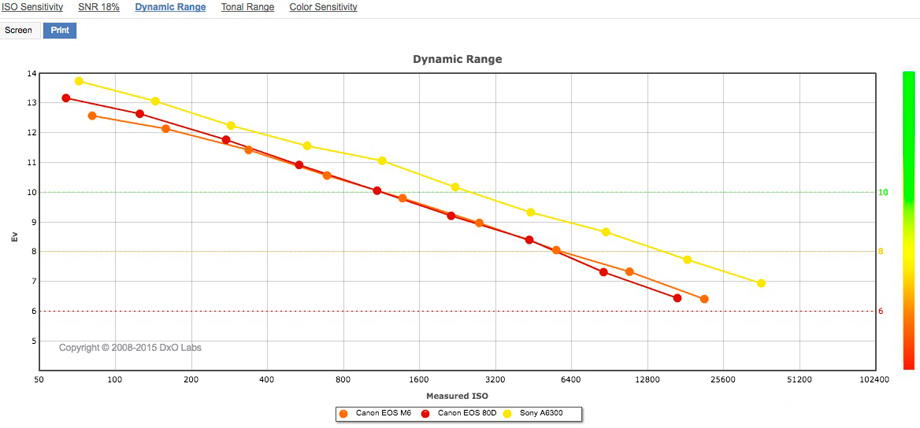
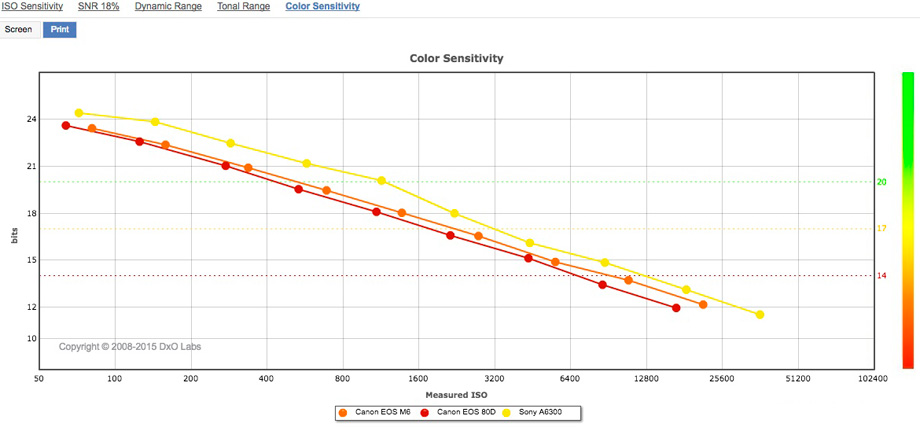
DXOMARK encourages its readers to share comments on the articles. To read or post comments, Disqus cookies are required. Change your Cookies Preferences and read more about our Comment Policy.